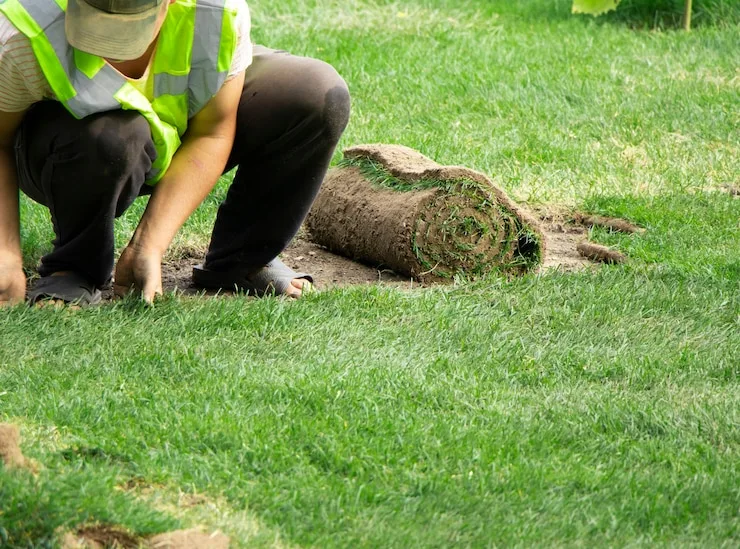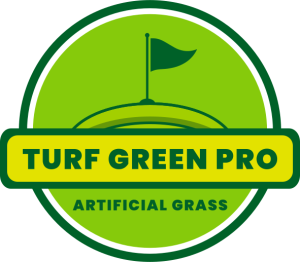Achieving the Perfect Lawn | Expert Lawn Installation by Turf Green Pro
Lawn installation is the foundation for creating a lush, vibrant yard that enhances curb appeal and provides a perfect space for relaxation and entertainment. Whether you’re looking to improve the aesthetics of your home or increase the functionality of your outdoor area, proper installation is crucial for long-term success. With Turf Green Pro, every detail of your lawn transformation is professionally managed, ensuring beautiful and lasting results. In this article, we’ll dive into the essential steps, including yard preparation, sod installation, and choosing the ideal grass type, to help make your lawn the envy of the neighborhood.
Sod Lawn Installation

For homeowners seeking an instant green landscape, sod lawn installation is the perfect solution. Unlike traditional seeding, sod provides immediate coverage, allowing your yard to look mature and complete from day one. At Turf Green Pro, we take pride in delivering professional sod installation services that ensure long-term success for your lawn.
The Advantages of Sod Installation
Sod is essentially pre-grown grass that is harvested and sold in rolls. It includes grass, soil, and root systems, which makes the grass easier to establish and more resilient once laid on your property. Some key advantages of sod installation include:
- Instant Aesthetic Appeal: Sod creates an instantly green lawn, saving you the time and effort of growing grass from seed.
- Erosion Control: Sod stabilizes soil quickly, making it an excellent option for preventing erosion in areas with slopes or loose soil.
- Less Weeding: Since sod is grown under ideal conditions and with fewer weed seeds, you’re less likely to experience weed problems.
At Turf Green Pro, our sod installation process involves grading and preparing the soil for proper drainage before laying the sod. This ensures that your lawn will stay healthy, rooted, and free from pooling water or uneven growth. We also guide homeowners on the necessary aftercare, such as regular watering, ensuring that the sod properly establishes itself in the first few weeks.
Preparing Your Yard for Lawn Installation
The success of your lawn installation largely depends on how well you prepare the yard before laying the grass. Whether you choose sod or seed, prepping your yard is essential for ensuring long-lasting grass growth. Turf Green Pro offers a step-by-step approach to help you properly prepare your lawn.
Step 1: Clearing the Area
The first step in preparing your yard is to remove any existing grass, weeds, rocks, or debris. Start by using a sod cutter or shovel to remove the old grass and its roots completely. This ensures that new grass has room to grow and establish roots without competition from old vegetation or weeds.
After removing the surface, examine the soil for large rocks, tree roots, or other debris that may hinder the lawn installation process. Removing these obstacles now will help create a smooth surface for grass growth.
Step 2: Soil Grading and Leveling
Proper grading of your yard is essential for maintaining effective drainage. When the soil is uneven, water may pool in certain areas, leading to dead spots in the grass. Leveling the soil by grading it away from structures, like your home or patio, will help ensure that water drains efficiently and doesn’t damage your foundation.
Turf Green Pro offers expert soil grading services to ensure your yard is level and ready for lawn installation. We understand the importance of creating a smooth surface that promotes healthy root development and minimizes the risk of standing water.
Step 3: Soil Preparation
Before laying sod or seed, it’s crucial to ensure the soil is rich in nutrients. Soil testing is an excellent way to determine your yard’s pH levels and nutrient content. If your soil is too acidic or lacking in key nutrients, adding organic matter like compost can help balance it out.
Additionally, aerating the soil allows for better water absorption and oxygen flow to the roots. Turf Green Pro recommends soil aeration for optimal grass growth, particularly in compacted areas or yards with heavy foot traffic.
Choosing the Right Grass Type for Your Yard

Selecting the ideal grass type is an important factor in determining how your lawn will perform over time. With various grass types available, it’s essential to consider your local climate, soil type, and yard usage when making a decision. At Turf Green Pro, we provide expert guidance on choosing the right grass for your specific needs.
Warm-Season Grasses
In warmer climates, like Dallas, warm-season grasses thrive, growing best in temperatures ranging from 75°F to 90°F. Common warm-season grasses include Bermuda grass, Zoysia grass, and St. Augustine grass. These grasses are known for their resilience to drought and heat, making them an ideal choice for Texas homeowners.
- Bermuda Grass: A fast-growing, durable grass type that thrives in full sun. It requires minimal watering once established and is highly resistant to foot traffic.
- Zoysia Grass: Known for its dense, soft texture, Zoysia grass is heat-tolerant and requires less frequent mowing.
- St. Augustine Grass: Often chosen for shaded areas, St. Augustine is known for its broad, thick blades and tolerance to moderate traffic.
Cool-Season Grasses
While cool-season grasses are more suitable for regions with cooler climates, they can also be used in areas with mild winters. These grasses, such as Kentucky bluegrass, fescue, and ryegrass, grow best in temperatures between 60°F and 75°F.
If your yard is shaded or receives limited sunlight, Turf Green Pro might recommend cool-season grasses that are more shade-tolerant and can thrive in lower light conditions.
Sunlight and Shade Requirements
Different grass types have varying requirements for sunlight. While Bermuda grass thrives in full sunlight, grasses like fescue perform better in shaded areas. It’s crucial to assess your yard’s sunlight patterns before choosing the grass type, as improper sunlight exposure can hinder the growth of certain varieties.
Turf Green Pro can help evaluate your yard’s exposure to sunlight and recommend the best grass type for long-term success.
Keeping Your Lawn Green and Healthy
Once your lawn is installed, proper maintenance is essential to keep it looking vibrant year-round. Turf Green Pro provides comprehensive lawn care solutions, including watering schedules, fertilization services, and mowing best practices. Regular yard maintenance helps prevent disease, promotes healthy growth, and keeps your lawn looking its best.
Watering
For newly installed sod or seed, watering is crucial during the first few weeks. Sod should be watered daily to help the roots establish. After the initial period, reduce watering to about 1-2 times per week, depending on weather conditions. Make sure to water early in the morning to minimize evaporation and ensure the grass absorbs moisture efficiently.
Mowing and Fertilizing
Avoid mowing your lawn too soon after installation. Let the grass grow to a healthy height (usually around 3-4 inches) before cutting it. Regular mowing promotes healthy growth and helps prevent thatch build-up.
Fertilizing your lawn will provide it with the necessary nutrients to thrive. Turf Green Pro recommends using a slow-release fertilizer to provide steady nourishment throughout the growing season. Always follow fertilization schedules based on the specific needs of your grass type.
Conclusion
A beautiful, green lawn starts with proper planning, installation, and care. Whether you opt for the instant results of sod lawn installation or take the time to prepare and seed your yard, Turf Green Pro is your go-to partner for achieving lawn perfection. From selecting the right grass type to professional installation and ongoing yard maintenance services, we ensure your yard becomes a welcoming and lush outdoor space. Contact Turf Green Pro today for expert lawn installation services that will leave your home looking its best.
FAQs
What is the best time of year for lawn installation?
The best time for lawn installation depends on the type of grass you’re installing. Warm-season grasses like Bermuda and Zoysia are best installed in late spring to early summer when temperatures are consistently warm. Cool-season grasses such as fescue are best installed in the early fall or spring, as they thrive in cooler temperatures.
How long does sod lawn installation take to establish?
Sod typically takes about two to three weeks to establish roots, depending on the weather and proper aftercare. During this time, it’s crucial to water the sod regularly and avoid heavy foot traffic.
What are the main benefits of sod installation over seeding?
Sod lawn installation offers immediate aesthetic appeal, erosion control, and fewer weed problems compared to seeding. While seeding can be more cost-effective, sod provides instant results and faster root establishment.
How do I prepare my yard for lawn installation?
Preparing your yard for lawn installation involves several steps, including removing old grass, clearing debris, grading the soil for proper drainage, and aerating or fertilizing the soil. Proper preparation ensures a healthy, long-lasting lawn. Turf Green Pro offers expert preparation services to make the process hassle-free.
What types of grass should I consider for my lawn?
The grass type you should choose depends on your climate, yard conditions, and usage. Warm-season grasses like Bermuda and St. Augustine are ideal for sunny, warm climates, while cool-season grasses such as fescue and Kentucky bluegrass are better suited for cooler temperatures or shaded areas. Turf Green Pro can help you determine the best option for your yard.
How much watering is required after lawn installation?
Newly installed sod or seed requires daily watering during the first few weeks to help the roots establish. After that, watering can be reduced to 1-2 times per week, depending on your grass type and local weather conditions. It’s essential to water early in the morning for optimal moisture absorption.
How soon after installation can I mow my lawn?
For sod installation, wait until the grass reaches a height of 3-4 inches before mowing. This usually takes about two to three weeks. For seeded lawns, mowing should be avoided until the grass reaches a similar height and is fully established.
